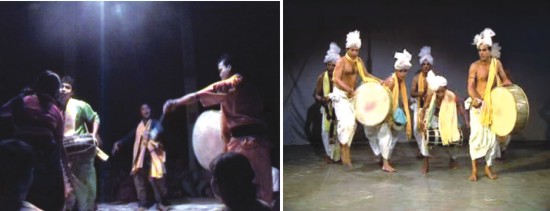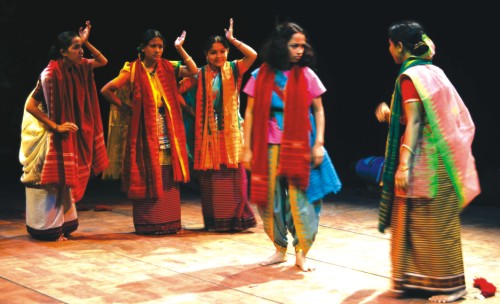|
Theatre
Where Body Meets the Soul
Ershad Kamol
Bangladesh, a country brimming with millions, is also a land of myth and history. It holds a diversified cultural identity where besides the majority Bangalis, there are several ethnic communities who live in the hinterland with their distinct cultural heritage. These unique traditions manifest themselves in the performing art forms, most of which incorporate the rituals of these ethnic minorities.
The ethnic Manipuri people, who live in Maulvibazar, have two sects. Of the Moithei and Vishnupriya strands, the latter in their ritualistic performance recreate the myths of Radha-Krishna's leela. A big part of it is Notpala; comprising of music, dance and drama, it is a ritualistic performance, which the Monipuris practise, the soul of which is the love of Radha and Krishna.
For the devout, the pala is not merely a performance, but it is a form of devotion. The central theme evolves around the idea of reuniting with the divine soul of Krishna by sacrificing all earthly desires.

For the devout, the pala is not merely a performance, but it is a form
of devotion.
In its tone and mood it shares some similarities with traditional Bangali pala. Traditional lyrical Manipuri Notpala, however, is reshuffled in every proceeding performance in accordance with the characteristics of the oral-narrative performance. It has four categories of speeches--pure narrative, descriptive with mixed dialogue, soliloquy and conversational. Though Monipuri Notpala is based on musical acting, Gouranga and Radha-Krishna, every character is visualised through the lead singer, who is called 'ishalpa' and is supported by co-actors called 'duar' and 'dohar'. ‘Duar’ enacts the role of Radha and 'ishalpa' plays Krishna.
Last week, to mark its 12th anniversary, Manipuri Theatre, a troupe of the Vishnupriya community, staged a Notapala performance at the Experimental Theatre stage of the Shilpakala Academy. Though Notpala is usually performed for four hours or more, the troupe's performance was only half-an-hour long. The group has even made a few changes to the traditional presentation to make it palatable for the urban audiences of the capital.
In such traditional performance the troupe members perform with circular movements accompanied by traditional Maripuri instruments such as 'mridanga' and 'mandira' at the centre of an open circular space; in courtyards or playground or the Mandaps of a temple. No raised stage is used, nor is there any set designing. The pala is presented without any set designing or heavy props such as curtains and background scenery.
But, on the rectangular shaped performing space at the Experimental Theatre Stage, the troupe changed the movements and motion. As it was a brief presentation of the traditional performance, the audience missed many interesting parts of the traditional Notpala performance. The troupe also presented 'Shree Krishna Kirtan' and 'Ingaal Andhar Pala' at the anniversary celebration programme.
Shree Krishna Kirtan is its 13th production. Young director Shubhashish Shameer has adapted the play into the Manipuri Vishnupriya language from a medieval Bangla masterpiece of the same title, written by Baru Chandidas. Chandidas wrote Shree Krishna Kirtan to highlight the anthropomorphic aspects of Lord Krishna. In the play, Shameer worked on only seven episodes out of 13 from Chandidas' masterpiece and presented the myth with a ritualistic performance.

Shubhashish Shameer's adaptation of Shree Krishna Kirtan depicts the stories in Vrindaban.
Shubhashish Shameer's adaptation of Shree Krishna Kirtan depicts the stories in Vrindaban such as love between Radha and Krishna, internal and external conflicts of Radha in her family life, Radha's devotion for Krishna, Barayi's role as a matchmaker and a conflict between love and duty that Krishna faced.
The presentation of Shree Krishna Kirtan is similar to Notpala but Shameer's directorial compositions did not give one the feeling of an authentic Manipuri performance. Rather, the experimental performance was a blending of dance-music-drama forms of traditional Manipuri such as Rash Leela performance, traditional Chakma music with dance form and some elements of modern western theatre.
Ingaal Aandhar Pala was another performance staged at the celebration programme. Written and directed by Shubhashish Shameer, depicting the struggles of a Manipuri 'mridanga' player Prem Singh, Ingaal Aandhar Pala features the ongoing oppression of the Bangali majority on ethnic minority Manipuri Vishnupriya community. Written and directed by Shubhashish Shameer, Ingaal Aandhar Pala is an experimental production. The story of the play unfolded as with a storyteller, a technique which is frequently used in traditional Bengali narratives. Even the narration was in Bangla when the dialogue was in the Manipuri Bishnupriya language.
The performances of the actors in colourfully clad Manipuri Bishnupriya clothes are praiseworthy; however, the pala itself has left much to be desired. Experimentation we may call it, but one cannot deny that what one has witnessed at the Shilpakala was not a distortion of the age-old Manipuri soul. Copyright
(R) thedailystar.net 2008
|
